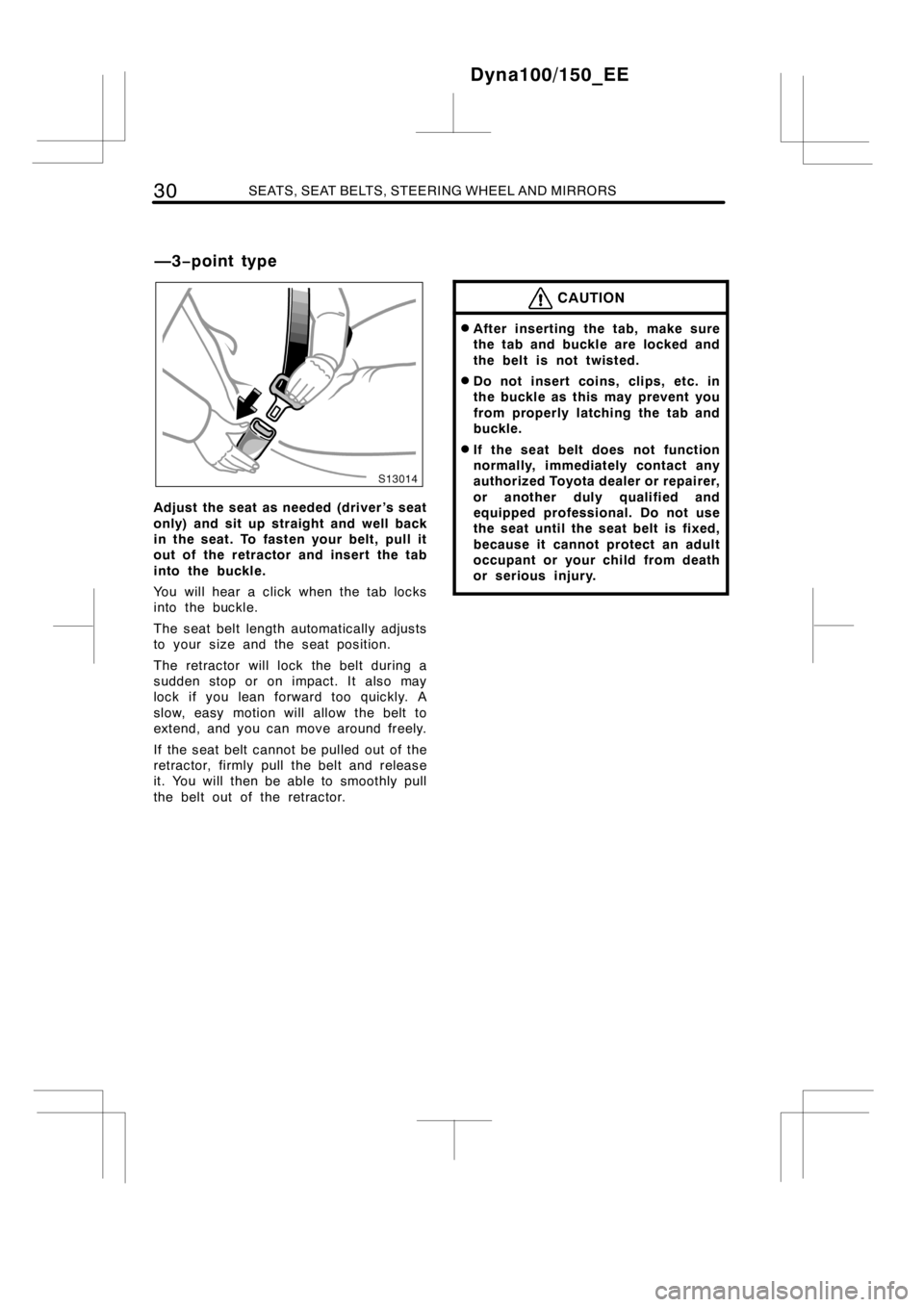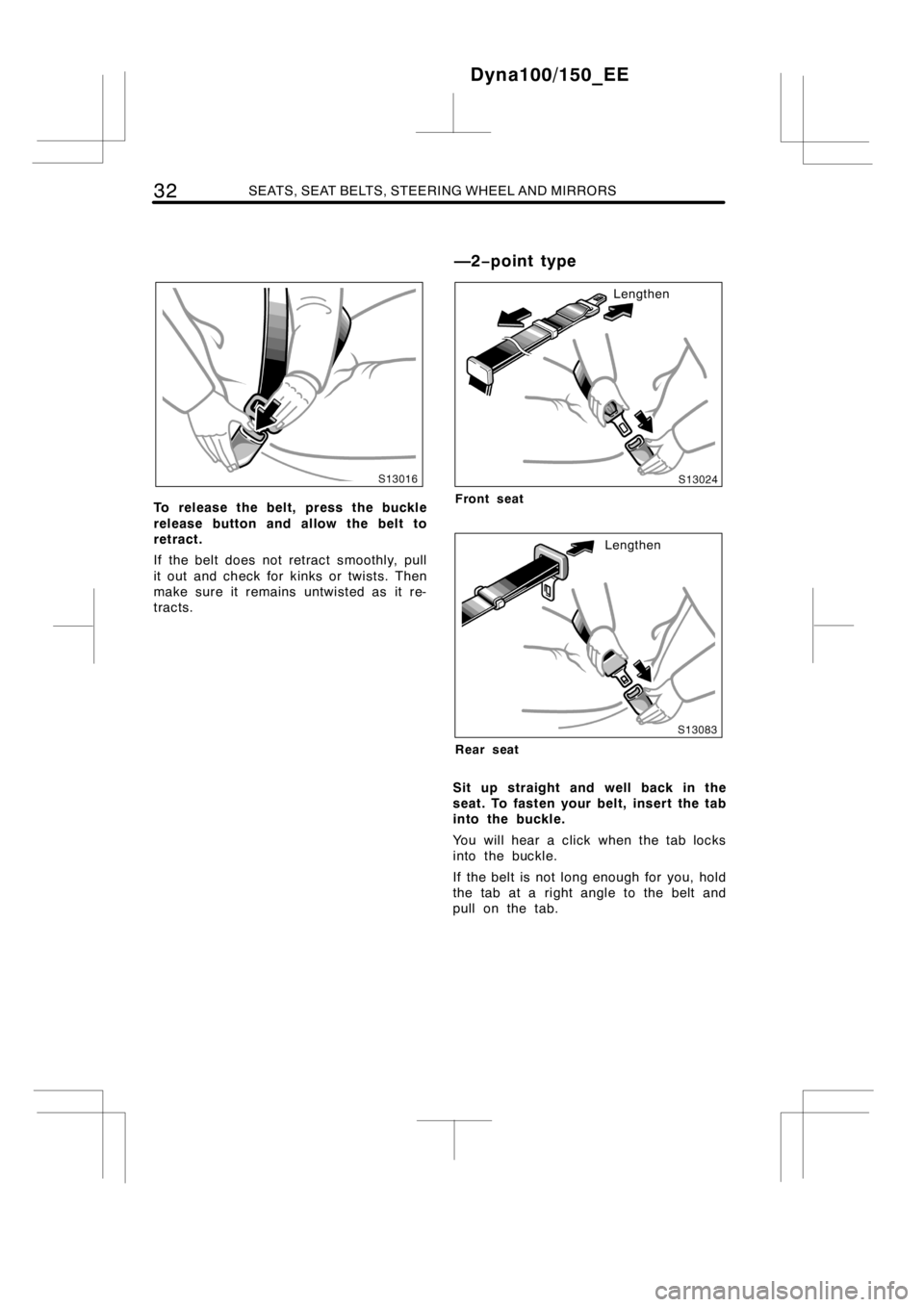2014 TOYOTA DYNA 100/150 length
[x] Cancel search: lengthPage 36 of 232

30SEATS, SEAT BELTS, STEERING WHEEL AND MIRRORS
Adjust the seat as needed (driver ’s seat
only) and sit up straight and well back
in the seat. To fasten your belt, pull it
out of the retractor and insert the tab
into the buckle.
You will hear a click when the tab locks
into the buckle.
The seat belt length automatically adjusts
to your size and the seat position.
The retractor will lock the belt during a
sudden stop or on impact. It also may
lock if you lean forward too quickly. A
slow, easy motion will allow the belt to
extend, and you can move around freely.
If the seat belt cannot be pulled out of the
retractor, firmly pull the belt and release
it. You will then be able to smoothly pull
the belt out of the retractor.
CAUTION
DAfter inserting the tab, make sure
the tab and buckle are locked and
the belt is not twisted.
DDo not insert coins, clips, etc. in
the buckle as this may prevent you
from properly latching the tab and
buckle.
DIf the seat belt does not function
normally, immediately contact any
authorized Toyota dealer or repairer,
or another duly qualified and
equipped professional. Do not use
the seat until the seat belt is fixed,
because it cannot protect an adult
occupant or your child from death
or serious injury.
Dyna100/150_EE
—3−point type
Page 38 of 232

32SEATS, SEAT BELTS, STEERING WHEEL AND MIRRORS
To release the belt, press the buckle
release button and allow the belt to
retract.
If the belt does not retract smoothly, pull
it out and check for kinks or twists. Then
make sure it remains untwisted as it re-
tracts.
Lengthen
Front seat
Lengthen
Rear seat
Sit up straight and well back in the
seat. To fasten your belt, insert the tab
into the buckle.
You will hear a click when the tab locks
into the buckle.
If the belt is not long enough for you, hold
the tab at a right angle to the belt and
pull on the tab.
Dyna100/150_EE
—2−point type
Page 39 of 232

SEATS, SEAT BELTS, STEERING WHEEL AND MIRRORS33
CAUTION
DAfter inserting the tab, make sure
the tab and buckle are locked and
the belt is not twisted.
DDo not insert coins, clips, etc. in
the buckle as this may prevent you
from properly latching the tab and
buckle.
DIf the seat belt does not function
normally, immediately contact any
authorized Toyota dealer or repairer,
or another duly qualified and
equipped professional. Do not use
the seat until the seat belt is fixed.
It cannot protect an adult occupant
or your child from death or serious
injury.
Adjust to
a snug fit
Keep as low on
hips as possibleTo o h i g h
Front seat
To o h i g h
Adjust to a
snug fit
Keep as low on
hips as possible
Rear seat
Remove excess length of the belt and
adjust the belt position.
To shorten the belt, pull the free end of
the belt.
Position the lap belt as low as possible
on your hips—not on your waist, then ad-
just it to a snug fit.
Dyna100/150_EE
Page 64 of 232

58SEATS, SEAT BELTS, STEERING WHEEL AND MIRRORS
To remove the junior seat:
Press the buckle release button and allow
the belt to retract.To adjust the steering wheel position,
pull up the lock release lever. Then tilt
the steering wheel to the desired angle,
push or pull it to the desired steering
column length and push down the lock
release lever.
CAUTION
DDo not adjust the steering wheel
while the vehicle is moving. Doing
so may cause the driver to mishan-
dle the vehicle and an accident may
occur resulting in death or serious
injuries.
DAfter adjusting the steering wheel,
try moving it up and down or for-
ward and rearward to make sure it
is locked in position.
Dyna100/150_EE
Tilt and telescopic steering
wheel
Page 130 of 232

124STARTING AND DRIVING
1. Check the area around the vehicle be-
fore entering it.
2. Adjust seat position, seatback angle,
steering wheel angle and length.
3. Adjust the inside and outside rear view
mirrors.
4. Close all doors.
5. Fasten seat belts.1. Apply the parking brake firmly.
2. Turn off unnecessary lights and acces-
sories.
3. Press the clutch pedal to the floor and
shift the transmission into neutral. Hold
the clutch pedal to the floor until the
engine is started.
Dyna100/150_EE
Before starting the engineHow to start the engine—
(a) Before cranking
Page 142 of 232

136STARTING AND DRIVING
TIRES
DEnsure that your vehicle’s tires are
properly inflated. See page 193 in Sec-
tion 7−2 and page 218 in Section 8 for
instructions.
DThe trailer tires should be inflated to
the pressure recommended by the trail-
er manufacturer in respect to the total
trailer weight.
TRAILER LIGHTS
DCheck for correct operation of the turn
signals and stop lights each time you
hitch up. Direct splicing may damage
your vehicle’s electrical system and
cause a malfunction of your lights.
BREAK−IN SCHEDULE
DToyota recommends that you do not
tow a trailer with a new vehicle or a
vehicle with any new power train com-
ponent (engine, transmission, differen-
tial, wheel bearing, etc.) for the first
800 km (500 miles) of driving.
MAINTENANCE
DIf you tow a trailer, your vehicle will
require more frequent maintenance due
to the additional load.
DRetighten all fixing bolts of the towing
ball and bracket after approximately
1000 km (600 miles) of trailer driving.
PRE−TOWING SAFETY CHECK
DBe sure not to exceed designated max-
imum load for the ball coupling of the
towing bracket. Please remember that
the ball coupling load will increase the
load on the vehicle. Maximum permissi-
ble rear axle capacity must not be ex-
ceeded.
DMake sure the trailer cargo is securely
loaded so that it cannot shift.
DIf the traffic behind the trailer cannot
be seen properly with the standard rear
view mirrors, additional outside mirrors
will be necessary. Both outside mirrors
must be fitted on folding arms and ad-
justed to give a good rear view at all
times.
TRAILER TOWING TIPS
Your vehicle will handle differently
when towing a trailer. In order to avoid
accident, death or serious injury, keep
the following in mind when towing:
DBefore starting out, check operation of
the lights and all vehicle−trailer connec-
tions. After driving a short distance,
stop and recheck the lights and con-
nections. Before actually towing a trail-
er, practice turning, stopping and back-
ing with a trailer in an area away from
traffic until you learn the feel.
DBecause stopping distance may be in-
creased, vehicle−to−vehicle distance
should be increased when towing a
trailer. For each 10 km/h (6 mph) of
speed, allow at least one vehicle and
trailer length between you and the ve-
hicle ahead. Avoid sudden braking as
you may skid, resulting in jackknifing
and loss of control. This is especially
true on wet or slippery surfaces.
DAvoid jerky starts or sudden accelera-
tion. Prevent excessive clutch slippage
by keeping engine rpm low and not
racing the engine. Always start out in
first gear.
DAvoid jerky steering and sharp turns.
The trailer could hit your vehicle in a
tight turn. Slow down before making a
turn to avoid the necessity of sudden
braking.
Dyna100/150_EE
Page 143 of 232

STARTING AND DRIVING137
DBacking with a trailer is difficult and
requires practice. Grip the bottom of
the steering wheel and move your hand
to the left to move the trailer to the
left. Move your hand to the right to
move the trailer to the right. (This pro-
cedure is generally opposite to that
when backing without a trailer.) Also,
just turn the steering wheel a little at
a time, avoiding sharp or prolonged
turning. Have someone guide you when
backing to reduce the risk of an acci-
dent.
DRemember that when making a turn,
the trailer wheels will be closer than
the vehicle wheels to the inside of the
turn. Therefore, compensate for this by
making a larger than normal turning
radius with your vehicle.
DCrosswinds and rough roads will ad-
versely affect handling of your vehicle
and trailer, causing sway. Pay attention
to the rear from time to time to pre-
pare yourself for being passed by large
trucks or buses, which may cause your
vehicle and trailer to sway. If swaying
happens, firmly grip the steering wheel
and reduce speed immediately but
gradually. Never increase speed. If it is
necessary to reduce speed, brake
slowly. Steer straight ahead. If you
make no extreme correction with the
steering or brakes, the vehicle and
trailer will stabilize.
DBe careful when passing other ve-
hicles. Passing requires considerable
distance. After passing a vehicle, do
not forget the length of your trailer and
be sure you have plenty of room be-
fore changing lanes.
DTo maintain engine braking efficiency,
when using engine braking, do not use
fifth gear.
DBecause of the added load of the trail-
er, your vehicle’s engine may overheat
on hot days (at temperatures over
30_C[85_F]) when going up a long or
steep grade with a trailer. If the engine
coolant temperature gauge indicates
overheating, pull off the road and stop
in a safe spot. Refer to “If your vehicle
overheats” on page 148 in Section 4.
DAlways place wheel blocks under both
the vehicle and trailer wheels when
parking. Apply the parking brake firmly.
Put the transmission in first or reverse.
Avoid parking on a slope with a trailer,
but if it cannot be avoided, do so only
after performing the following:
1. Apply the brakes and hold.
2. Have someone place wheel blocks un-
der both the vehicle and trailer wheels.
3. When the wheel blocks are in place,
release your brakes slowly until the
blocks absorb the load.
4. Apply the parking brake firmly.
5. Shift into first or reverse and turn off
the engine.
When restarting out after parking on a
slope:
1. With the clutch pedal depressed, start
the engine.
2. Shift into gear.
3. Release the parking brake and slowly
pull or back away from the wheel
blocks. Stop andapply your brakes.
4. Have someone retrieve the blocks.
Dyna100/150_EE
Page 144 of 232

138STARTING AND DRIVING
CAUTION
DObserve the legal maximum speeds
for trailer towing.
DSlow down and downshift before
descending steep or long downhill
grades. Do not make sudden down-
shifts while descending steep or
long downhill grades.
DAvoid holding the brake pedal down
too long or too frequently. This
could cause the brakes to overheat
and result in reduced braking effi-
ciency.
Improving fuel economy is easy—just take
it easy. It will help make your vehicle last
longer, too. Here are some specific tips
on how to save money on both fuel and
repairs:
DKeep your tires inflated at the cor-
rect pressure.Underinflation causes
tire wear and wastes fuel. See page
193 in Section 7−2 for instructions.
DDo not carry unneeded weight in
your vehicle.Excess weight puts a
heavier load on the engine, causing
greater fuel consumption.
DAvoid lengthy warm−up idling.Once
the engine is running smoothly, begin
driving—but gently. Remember, howev-
er, that on cold winter days this may
take a little longer.
DAccelerate slowly and smoothly.
Avoid jackrabbit starts. Get into high
gear as quickly as possible.
DAvoid long engine idling.If you have
a long wait and you are not in traffic,
it is better to turn off the engine and
start again later.
DAvoid engine lugging or over−rev-
ving.Use a gear position suitable for
the road on which you are travelling.
DAvoid continuous speeding up and
slowing down.Stop−and−go driving
wastes fuel.
DAvoid unnecessary stopping and
braking.Maintain a steady pace. Try
to time the traffic signals so you only
need to stop as little as possible or
take advantage of through streets to
avoid traffic lights. Keep a proper dis-
tance from other vehicles to avoid sud-
den braking. This will also reduce wear
on your brakes.
DAvoid heavy traffic or traffic jams
whenever possible.
DDo not rest your foot on the clutch
or brake pedal.This causes premature
wear, overheating and poor fuel econo-
my.
Dyna100/150_EE
How to save fuel and make
your vehicle last longer